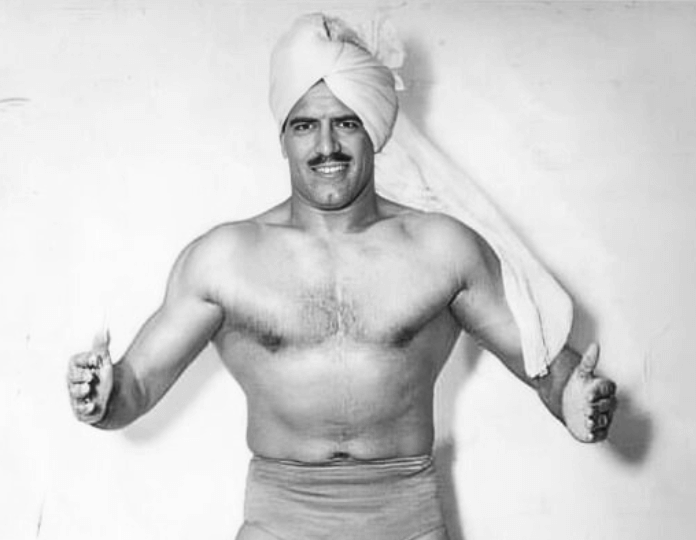The biggest star in India’s rich tradition of stunt cinema, Dara Singh is also the most loved. A global wrestling superstar, Dara Singh’s transition to cinema gave the swashbuckler and sword-and-sandal films a new lease of life. His legendary status made “Dara Singh” synonymous with bravado and strength, endearing him to audiences and cementing his legacy in Indian cinema.
Early Life and Career
Dara Singh was born Deedar Singh Randhawa on November 19, 1928, in the village of Dharmuchak, Punjab, into a farming family. His parents, Surat Singh Randhawa and Balwant Kaur, belonged to a Punjabi Jat Sikh family. He grew up in a modest farming household with siblings, including his brother Randhawa, who also became a wrestler and actor. Dara’s early years involved working on family farms, where his physical strength emerged. At age nine, he showed an interest in traditional wrestling, known as Pehlwani, shaped by local akhada culture. His early life was marked by the simplicity of rural India. However, his destiny was far from ordinary. Standing at 6 feet 2 inches tall and weighing 127 kilogrammes, his physical prowess was evident from a young age.
At the age of 18, he went to Singapore, where his father and uncle were working at the time. In Singapore, He started working in a drum manufacturing mill while training under Harnam Singh at the Great World Stadium. He continued to train for several years and was famous in local wrestling circles. After switching to professional wrestling, he competed against big names such as Bill Verna, Firpo Zbyszko, John Da Silva, Rikidōzan, Danny Lynch, Ski Hi Lee, and King Kong.
He quickly rose to prominence, earning the title of “Rustam-e-Hind” for his unmatched skills in the ring. His most memorable fights include his victory over George Gordienko for the Commonwealth Championship in 1959 and his win against Lou Thesz in 1968, which earned him the World Championship title.
Dara Singh In Films

Dara Singh ventured into the world of cinema, making his acting debut with “Sangdil (1952),” where he shared the screen with the legendary Dilip Kumar and Madhubala. However, it was Babubhai Mistry‘s 1962 film “King Kong” that catapulted him to stardom, where he played the titular role and showcased his wrestling prowess.
After the success of the film, he quickly became a household name with his portrayal of robust and heroic characters. His early work included films like Rustom-E-Baghdad (1963), Awara Abdulla (1963), Aaya Toofan (1964), Jagga (1964), Darasingh: Ironman (1964), Sher Dil (1965), Saat Samundar Paar (1965), Mahabharat (1965), Lootera (1965), Dulla Bhatti (1966), Naujawan (1966), Veer Bajrang (1966), Dada (1966), Chand Par Chadayee (1966), Thief of Baghdad (1969), Toofan (1969), Choron Ka Chor (1969), and many more.
The Superstar of Action Films
Singh’s collaboration with actress Mumtaz in the 1960s and 1970s resulted in a series of hit films that are still remembered fondly. Their on-screen chemistry was palpable in movies like “Faulad’ (1963),” “Veer Bhimsen (1964),” Samson (1964), “Hercules’ (1964),” Aandhi Aur Toofan (1964), and “Tarzan Comes to Delhi (1965).” Sikandar-E-Azam (1965), Rustom-E-Hind (1965), Raaka (1965), Boxer (1965), Khakaan (1965), Jawan Mard (1965), Daku Mangal Singh (1966), Do Dushman (1967), and Jung Aur Aman (1968).
In the 1970s, he started doing character roles in mainstream films, starting with Raj Kapoor’s Mera Naam Joker. He followed by films like Nanak Dukhiya Sab Sansar. (1970), Anand (1971), Lalkaar (1972), Kuwara Baap (1974), Dharam Karam (1975), Dharmatma (1975), Mard (1985), Karma (1986), Shehzaade (1989), Elaan-E-Jung (1989), Pratiggya (1995, Punjabi), Prem Deewane (1992), Dillagi (1999), Dulhan Hum Le Jayenge (2000), Kal Ho Naa Ho (2003), Jab We Met (2007), and many more.
Dara Singh On TV
One of Singh’s most iconic roles was that of Hanuman in the mythological film “Bajrangbali (1976).” He later played Hanuman in Ramanand Sagar‘s television series “Ramayan.” His portrayal of Hnuman was so convincing and powerful that it became synonymous with his identity. He reprised his role in Ramanand Sagar’s “Luv Kush,” and had a cameo in BR Chopra’s “Mahabharat.”
He also acted in shows like Vikarm and Betal (1985), Hudd Kar Di (1998), Family Business (2004), Aurat Teri Yehi Kahaani (2004), and Zamane Ko Dikhana Hai (2005).
In addition to acting, Dara Singh also ventured into directing, producing, and writing for films. He directed seven Punjabi films, including “Sawa Lakh Se Ek Ladaun (1976),” “Rab Dian Rakhan (1996),” and “Nanak Dukhiya Sub Sansar (1970),” as well as Hindi films like “Bhakti Mein Shakti (1978)” and “Rustom (1982).”
Personal Life
Dara Singh was married twice; his first marriage was to Bachno Kaur, which lasted from 1942 until their divorce in 1952. He then married Surjit Kaur in 1961, who stood by his side until his passing in 2012.
Together with Surjit Kaur, Dara Singh had six children: three sons, Vindu Dara Singh, Parduman Randhawa, and Amrik Singh Randhawa, and three daughters, Loveleen Singh, Kamal Singh, and Deepa Singh.
Dara Singh’s passing on July 12, 2012, left a void in the hearts of many, but his legacy continues to inspire generations. He was posthumously inducted into the WWE Hall of Fame Class of 2018, a fitting tribute to a man who was, in every sense, larger than life.
Dara Singh on IMDB